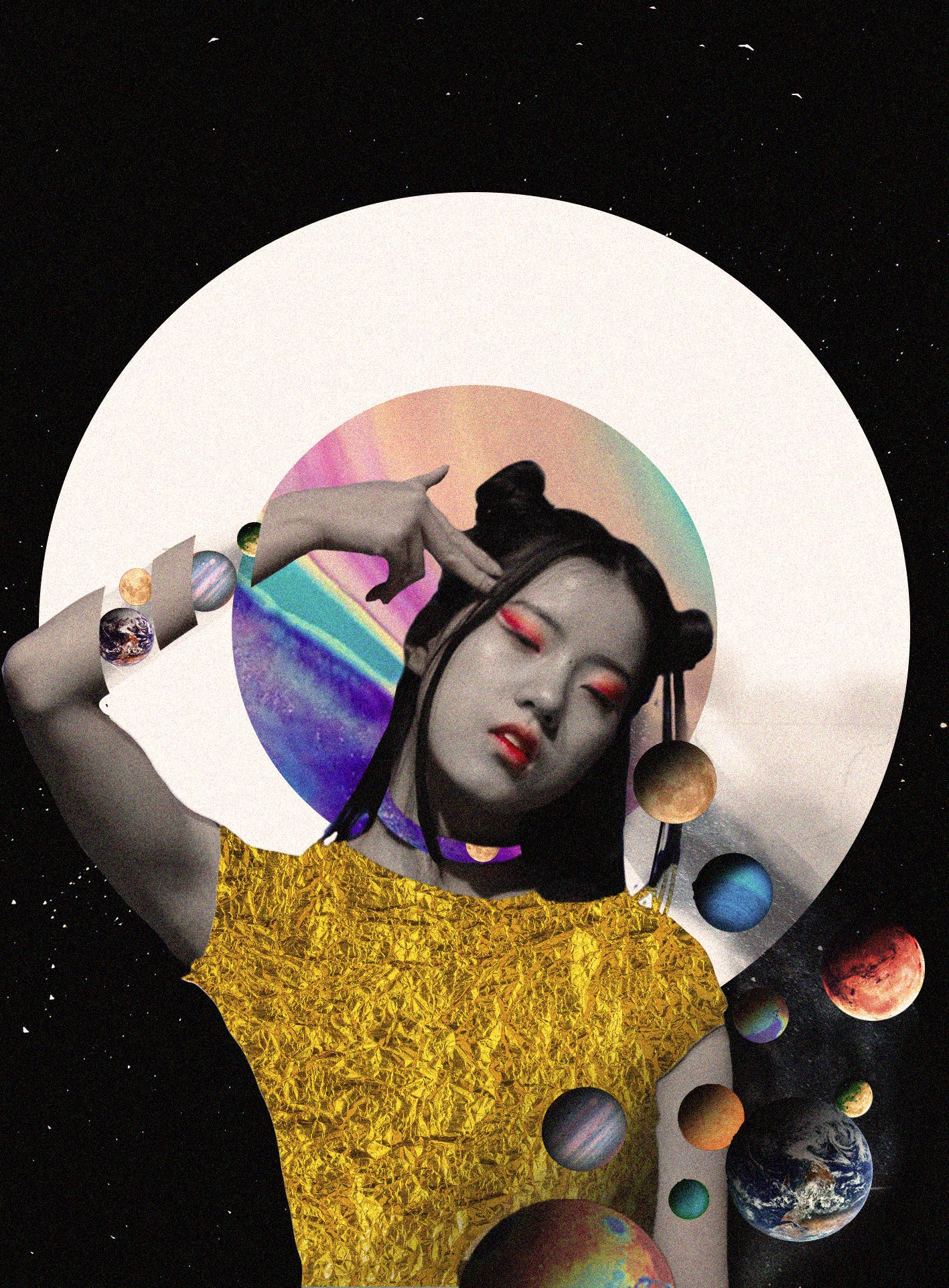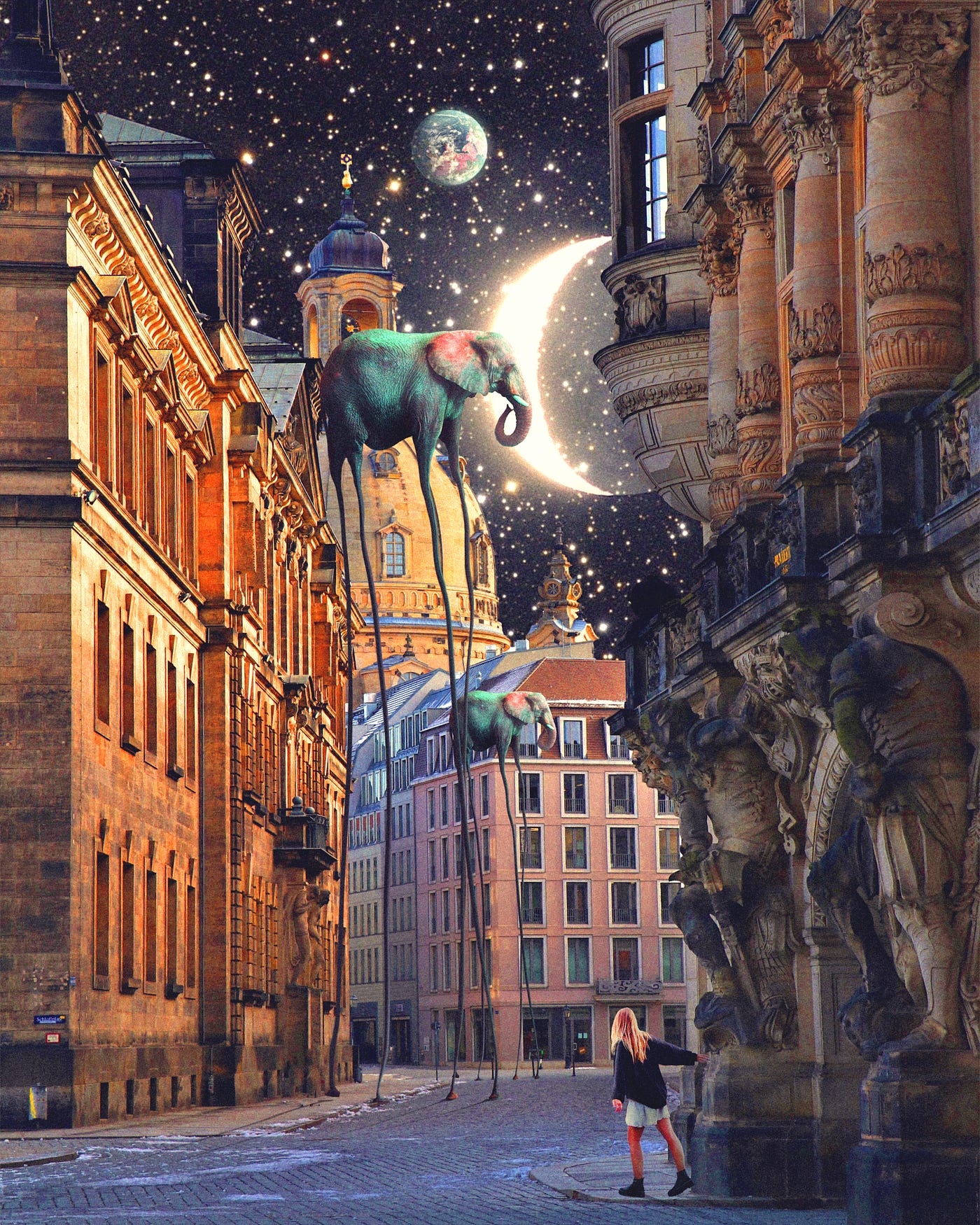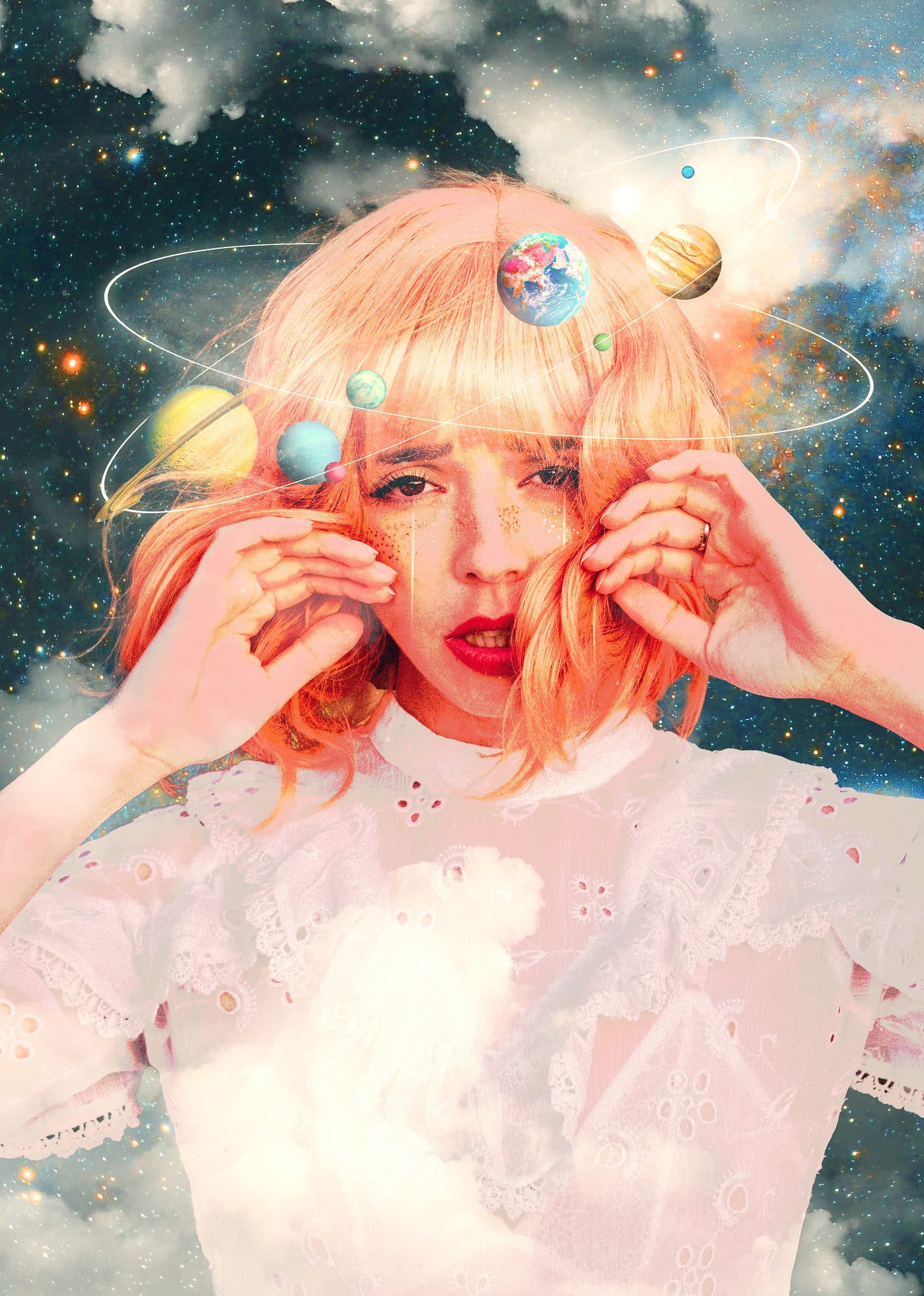 |
| Larisa “Morysetta” Murariu is a Romanian artist and graphic designer |
Morysetta's Digital Art Revolution
April 11, 2021
 |
| Larisa “Morysetta” Murariu |
Larisa “Morysetta” Murariu is a Romanian artist and graphic designer whose surreal collages have been featured on countless digital art platforms as well as in galleries and art festivals from Bucharest to Laguna Beach. She has also created artwork for numerous music projects by recording artists worldwide. With no formal training, in a few short years, Morysetta has garnered almost 270,000 followers on Instagram alone. Last week, her sophomore collection for Crypto.com NFT sold out in only 12 minutes — and the drop’s rarest piece, a one-of-a-kind collectible titled “Void,” recently resold for a 2,500% increase from its original price. At the time of this interview’s publishing, it is currently listed on the marketplace for $3,700,000.
 |
| Morysetta’s “Void” from her “ESCAPISM” collection. |
Titled “ESCAPISM,” the collection featured seven original collages designed to expand consciousness and encourage creative freedom — bringing new meaning to the idiom “let your mind wander” — at a time when travel, or physical escapism, is hindered. Sold in the form of surprise art packs containing one artwork apiece, to be virtually unwrapped and kept or traded on the secondary marketplace, the aforementioned NFT and 20 editions of each of the others were distributed among the 121 packs at random. The drop was a followup to the digital surrealist’s first collection, “Collage Mirage: Morysetta,” released in April.
 |
| Morysetta’s “Baked” from her “Collage Mirage” collection. |
For Murariu, an artistic career had been a lifelong dream, but it wasn’t until she discovered her passion for digital collage in 2018 — almost by accident — that she truly found her calling and made it a reality. In her mid-20s, Murariu was at a crossroads; having been previously discouraged from pursuing the arts professionally, a primal aspiration was awakened within her — so she decided to fuel her creative drive, share her art publicly and eventually try to monetize her work. After experimenting with drawing, painting, digital rendering and even some mandala art, Morysetta began selling custom, handbound journals. It was in designing one for herself that she made her first collage, utilizing what would become her signature style.
 |
| A drawing by Morysetta, a subsequent collage inspired by the drawing and her first collage — designed as a cover for her personal journal. |
 |
| A drawing by Morysetta, a subsequent collage inspired by the drawing and her first collage — designed as a cover for her personal journal. |
 |
| A drawing by Morysetta, a subsequent collage inspired by the drawing and her first collage — designed as a cover for her personal journal. |
The response to her initial collage was fervent, and she reveled in the opportunities for self-expression that the medium presented her — allowing Morysetta to focus less on technique and more on developing her ideas and message. Perhaps ironically, using found imagery, her work became more personal — leading the artist on a path of self-discovery and exploring themes like feminism, power structures, the creative process and humankind’s relationship with technology.
 |
| Morysetta’s “Anguish” from her “ESCAPISM” collection. |
Paradoxically, Murariu’s work is both grounded and ethereal, juxtaposing worldly, often nostalgic imagery with extraterrestrial scenery — or vice versa — on a cosmic scale. Even her early experiments with other mediums are characterized by trippy psychedelic visuals with a very human edge. Full of whimsical retro-futuristic symbolism, her interdimensional art celebrates all things alien and unknown in a very tangible, relatable way — at times making social commentary, at others more introspective, but never without a certain playfulness or sense of humor. Borrowing from the past and predicting the future, but with messages rooted in the present, Morysetta’s collages tell timeless stories designed to stimulate thought that truly resonate with her global audience.
“I think the NFT space produced an art revolution.”
Crypto.com NFT spoke with Morysetta about her evolution as an artist, what she loves about working in collage, her foray into NFTs, how they have affected the perception of digital art and her future plans in the space.
Read the interview below and search the Crypto.com NFT marketplace
for available editions from both of her collections.
 |
| Morysetta’s “Half and Half” from her “ESCAPISM” collection. |
When did you first realize you wanted to be a professional artist?
In the back of my head, I’ve always imagined myself as an artist — but as time went by, it really just seemed like a ridiculous childish dream. Around the age of 25, I had this life changing moment — I guess it was like a revelation — and came to the conclusion that I’ve only got one life to make this happen, so I might as well give it a try. Time is passing by, anyway.
What led you to that point?
I’ve been doing arts and crafts since I was a little kid, but no one really took me seriously. My biggest wish was to be in art school, but my parents didn’t want that for me — so I continued my studies, just like everyone else I knew around me. Art was more of an outlet for when I was feeling down; I used to draw or paint maybe once a year, if even.
“I used to be very focused on technique, when drawing —
so much so that the drawing itself had no meaning.”
I grew up in Buzau and moved to Bucharest to go to university when I was 19. Coming to Bucharest, I think, just pushed me further away from art. I finished getting a license degree and then I got a job while doing my masters, [so] there wasn’t really a lot of time left for anything else — or will power, in general.
 |
| Morysetta’s “Mind Traveler” from her “Collage Mirage” collection. |
Do you have any formal training, or are you completely self-taught?
I don’t have any formal training. I’ve learned how to do a lot of things from YouTube. With collaging, [there were] a lot of things that I’ve learned that came together — such as Photoshop, scrapbooking and digital painting.
What do you consider “good” art?
I like art that tells a story, that makes you leave where you are and who you are for a second — so [that] you can be where the artwork takes you.
What do you love most about working in collage?
Precisely the fact that I can tell a story easily. I can work anywhere, as long as I have my tablet with me, and that really helped me get a lot more work done in any downtime I had. It’s so much easier to get the tablet out of the drawer than setting up all my crayons and paper, and [my] space.
 |
| Morysetta’s “Peace of Mind” from her “ESCAPISM” collection. |
What’s more important: technique or message?
I used to be very focused on technique, when drawing — so much so that the drawing itself had no meaning. Most of the time, it was just a face — no interesting expresion [or] nothing — just a face, drawn somewhat OK. When I discovered collaging, I felt like my art became my voice — I felt like I could literally show people how I feel on the inside, instead of trying to either explain or hide it.
“When I discovered collaging, I felt like my art became my voice.”
Now, mastering both technique and message is mastery level. I admire Salvador Dali; I think he mastered depicting reality, and then he distorted it — and so did Pablo Picasso.
 |
| Morysetta’s “Summer Nights for Lonely Days” from her “ESCAPISM” collection. |
What’s your favorite artistic movement, throughout time?
Definitely surrealism. I love the visual play of the subconscious and distortion of reality. It challenges reality and throws you into a pit of the imaginary.
If you could collaborate with any artist in history, who would it be?
I don’t think I’m worthy of this honor, and I would be surprised if any of my favorite artists would even glance at me. I would have loved to have met Salvador Dali, just to get to see him alive would have been such an honor.
If there’s a common theme in almost all of your art, I think it would be “space”; what does space represent to you?
I use space as a depiction of the subconscious, as they are both infinite. I have this belief that when we die, we all melt into this soup of life energy from which life force is then again created. Space represents just that: the unknown, the unexplored, the part of us that we don’t really understand.
 |
| Morysetta’s “Gone” from her “ESCAPISM” collection. |
Why do you think space-themed NFTs are so popular, both as subject matter for artists and for collectors?
I think maybe the recent space launch events might have a big part to do with it, especially for collectors. For artists, I imagine they feel the same when creating their artwork as I do when I create mine.
How did you get into NFTs?
I think the first time I ever heard of NFTs was in the email I received from you guys. I have to be honest, I didn’t give it too much attention at first — but then a couple of days later, all I was hearing about in the art community was NFTs and I looked more into it.
What do you like most about working in the NFT space?
It gave a lot of credibility to digital art in general, and I think it brought it to the same level as traditional art that might be sold at auction. I think the NFT space produced an art revolution.
How were you monetizing your art before NFTs?
The same way I still continue to: I mostly do a lot of album release art and album covers.
 |
| Morysetta’s “On the Brink of Impossible” from her “Collage Mirage” collection. |
What were some of your favorite projects?
I don’t necessarily have favorite projects, I have favorite customers. I had projects that took a longer period of time and working with people efficiently, and really getting along, is something I really appreciate and value.
What are your goals or future plans for your art, in the NFT space or otherwise?
I plan on trying to learn some animation and see where that takes me.
Do you still do work in other mediums?
I haven’t done any kind of traditional art in years, but it’s not something I necessarily regret. I’d just like to become more and more better in the digital space, and expand in this direction.
 |
| Morysetta’s “Cosmic Tribulation” from her “Collage Mirage” collection. |
Find Morysetta’s available NFTs on the Crypto.com NFT marketplace
Larisa “Morysetta” Murariu, "Back and Forth"
Larisa “Morysetta” Murariu, "I'll Just Be Waiting"


Gerçekten güzel anlatılmış, tebrikler.
ReplyDeleteThank you. I very much enjoyed putting this piece together.
ReplyDelete